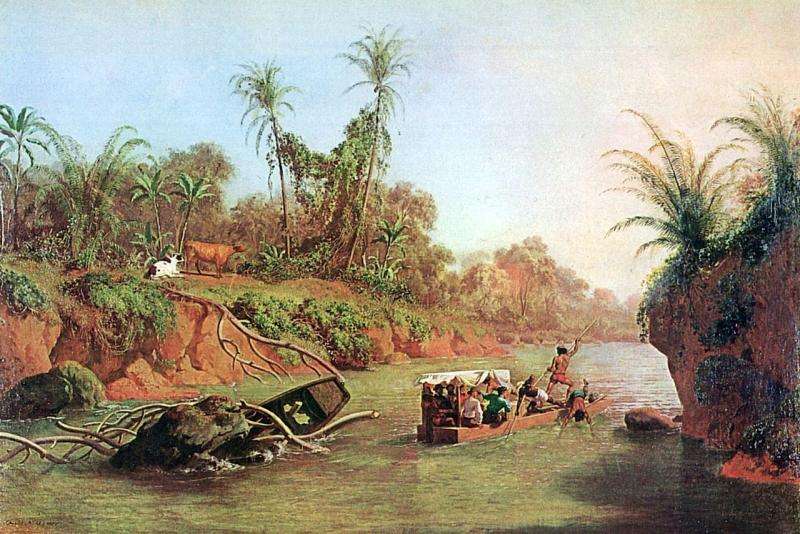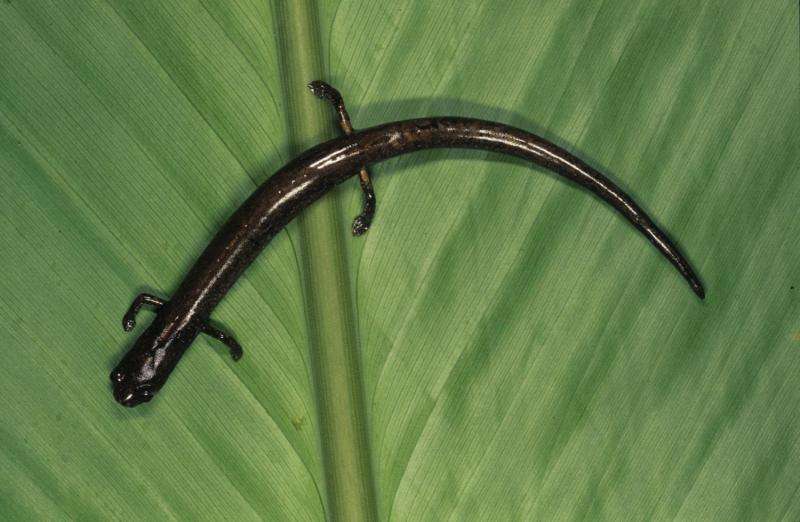An 1850 oil painting by Charles Christian Nahl, titled, The Isthmus of Panama on the height of the Chagres River
(Phys.org)—A team of researchers with members from Panama, Sweden, Switzerland and the U.S. has found evidence that suggests the Isthmus of Panama was formed much earlier than has been thought by most in the research community. In their paper published in Proceedings of the National Academy of Sciences, the team describes how they undertook a detailed study of fossil and molecular data of both terrestrial and marine life to create a better picture of the way the Isthmus came to be.
Conventional theory has placed the formation of the Isthmus of Panama at approximately 3.5 million years ago, connecting the North and South American continents. That event marked a major evolutionary occurrence for the planet as it allowed plants and animals to cross between the two continents, while simultaneously cutting off marine life that once passed between them—it also had a major impact on worldwide weather as the water flow between the Caribbean Sea and the Pacific Ocean was stopped. In this new effort, the researchers report that they have found evidence that shows the Isthmus was formed in a stop-and-go manner that began as far back as 20 million years ago.
To come to this conclusion, the team looked at fossil and molecular data collected from specimens found on both ends of the Isthmus as well as specimens that came from the sea. They claim their analysis shows that migrations between the two continents started much earlier than has been thought and that there were periods where such migrations were halted which meant the Isthmus had been covered over by water for a time, again, before rising to finally form the land mass we have today. Species passed between, the two continents, they report, at a reasonably steady pace, up until approximately six million years ago—at that point, the migration picked up in very noticeable ways.
The team plans to continue their research, looking for answers to such questions as to why it appears mammals took so much longer to migrate between the two continents than did other organisms. They also believe that because many modern models used to predict future climate change are based on assumptions from the past that include the Isthmus forming much more recently than it really did, some changes are going to have to be made to them.
Scientists think that salamanders from North America arrived in South America before the accepted date for the closure of the Isthmian land bridge 3 million years ago, supporting Bacon et al's assertion that the Isthmus closed at an earlier date. Credit: STRI Archives
More information: Biological evidence supports an early and complex emergence of the Isthmus of Panama, Christine D. Bacon, PNAS, DOI: 10.1073/pnas.1423853112
Abstract
The linking of North and South America by the Isthmus of Panama had major impacts on global climate, oceanic and atmospheric currents, and biodiversity, yet the timing of this critical event remains contentious. The Isthmus is traditionally understood to have fully closed by ca. 3.5 million years ago (Ma), and this date has been used as a benchmark for oceanographic, climatic, and evolutionary research, but recent evidence suggests a more complex geological formation. Here, we analyze both molecular and fossil data to evaluate the tempo of biotic exchange across the Americas in light of geological evidence. We demonstrate significant waves of dispersal of terrestrial organisms at approximately ca. 20 and 6 Ma and corresponding events separating marine organisms in the Atlantic and Pacific oceans at ca. 23 and 7 Ma. The direction of dispersal and their rates were symmetrical until the last ca. 6 Ma, when northern migration of South American lineages increased significantly. Variability among taxa in their timing of dispersal or vicariance across the Isthmus is not explained by the ecological factors tested in these analyses, including biome type, dispersal ability, and elevation preference. Migration was therefore not generally regulated by intrinsic traits but more likely reflects the presence of emergent terrain several millions of years earlier than commonly assumed. These results indicate that the dramatic biotic turnover associated with the Great American Biotic Interchange was a long and complex process that began as early as the Oligocene–Miocene transition.
Journal information: Proceedings of the National Academy of Sciences
© 2015 Phys.org























